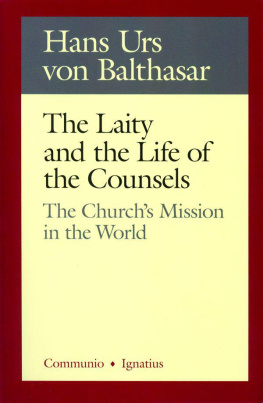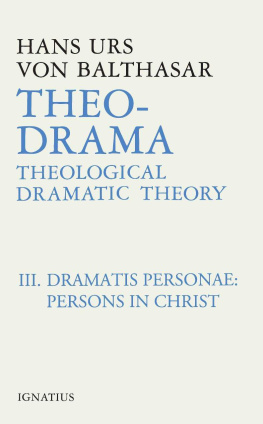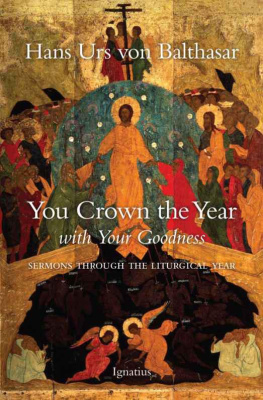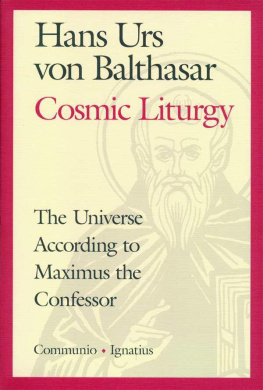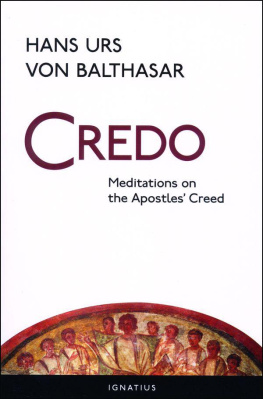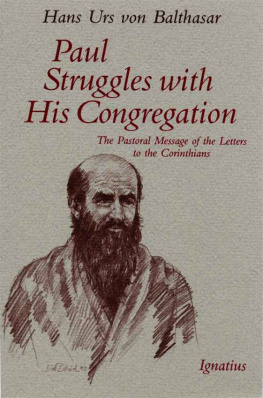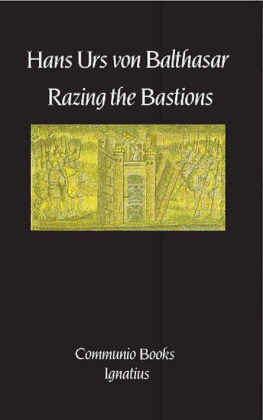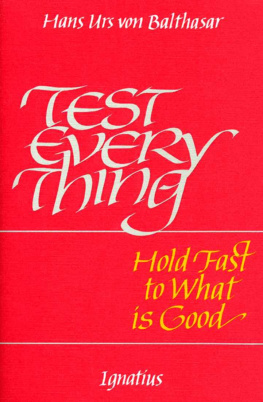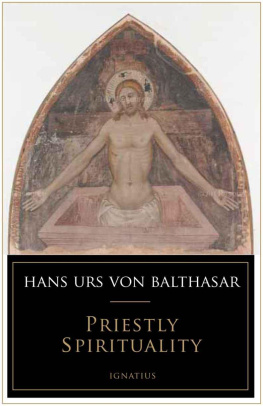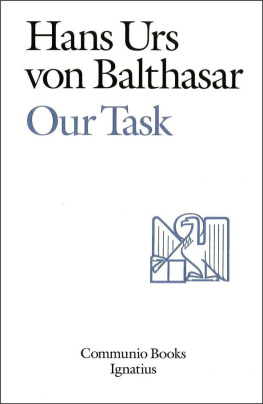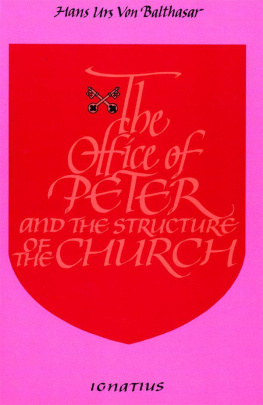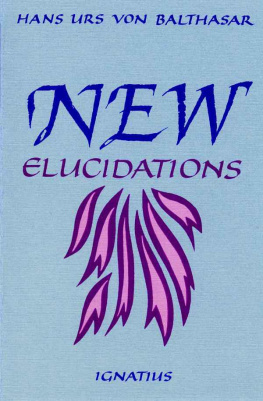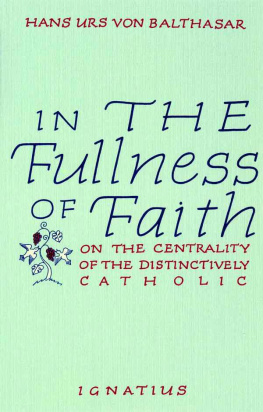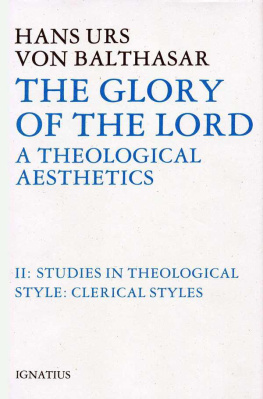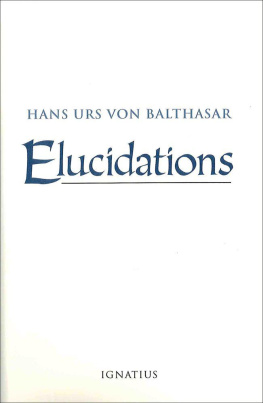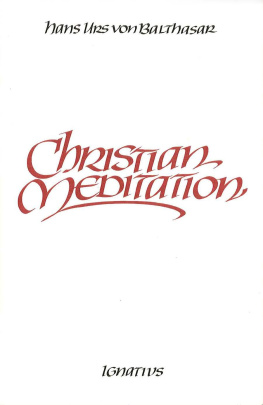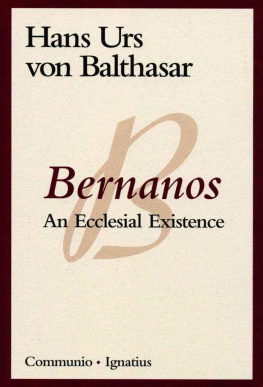The Laity and the Life of the Counsels
HANS URS VON BALTHASAR
The Laity and the
Life of the Counsels
The Churchs Mission in the World
T RANSLATED BY B RIAN M C N EIL, C.R.V. WITH D.C. S CHINDLER
A COMMUNIO BOOK
IGNATIUS PRESS SAN FRANCISCO
Original German edition:
Gottbereites Leben: Der Laie und der Rtestand
Nachfolge Christi in der heutigen Welt
1993 Johannes Verlag, Einsiedeln
Cover by Roxanne Mei Lum
2003 Ignatius Press, San Francisco
All rights reserved
ISBN 978-0-89870-572-0
Library of Congress Control Number 2002113185
Printed in the United States of America
CONTENTS
PART ONE: THE LAYMAN AND THE
LIFE OF THE COUNSELS
PART TWO: THE EVANGELICAL
COUNSELS IN TODAYS WORLD
a. Theology of the states of life
b. On the concept of counsel
c. The multiplicity of the counsels
d. The individual counsels
e. Vows and office: The immeasurable mystery of the Church
a. On the origins of lay movements in the Church
b. Lay movements and the ecclesial states of life
c. Reasons for the development of lay movements today
d. The specific mission of the laity as mediators between Church and world
a. Many missions within the one faith
b. Challenges facing lay movements spiritualities
c. The movement and the individual
d. The movement and the Church
e. The movement and the world
f. Reciprocal relationships among movements
ABOUT THIS BOOK
(Preface to the German edition)
The author had planned a new edition of his book Der Laie und der Ordensstand [The laity and the religious state] before his death, with the new title: Der Laie und der Rtestand [The laity and the state of the counsels] and the corresponding adjustments in the text. Carrying out his plan has given us the occasion to include in this publication some of his earlier writings about the layman in the Church, especially about the consecrated layman. These writings are now very difficult to obtain otherwise. We have given the publication [the German edition] a new title, which likewise comes from the author himself: Gottbereites Leben [A life held in readiness for God].
Der Laie und der Ordensstand appeared in 1948, in the place of the more comprehensive work Christlicher Stand [ The Christian State of Life , 1983] (which was not made available for publication at that time), immediately after Das Herz der Welt (1945) [ The Heart of the World , 1979] and Wahrheit I: Wahrheit der Welt (1947) [ Truth, I: The Truth of the World ], as a third important accent in Hans Urs von Balthasars work, a kind of pointer to a possible answer man could make to this heart and this truth. The following of Christ was and remained for him in all its forms a most profound concern, to which he returned again and again; it is an idea that conditions the totality of his mighty oeuvre and gives it an ultimate pastoral orientation. A great inner joy streams out of these works, a deep love for reality: here a path emerges.
The essays have been included without any changes in their chronological order. Two later writings, scarcely known in the German-speaking world, form the introduction and the conclusion to this volume: Gottbereites Leben: Uber den Sinn des Rtelebens heute [A life held in readiness for God: On the meaning of the life of the counsels today] (1971) and Laienbewegungen in der Kirche [Lay movements in the Church] (1987).
Since the ecclesiastical documents concerning secular institutes ( Provida Mater, Primo feliciter, Cum Sanctissimus , and other texts in the selection made by Jean Beyer, S. J.) have been published [in German] as a separate volume by Johannes Verlag in 1963, we have omitted the appendix to the Herder edition of Der Laie und der Ordensstand (1949). The texts from the ecclesiastical documents quoted in that book have been replaced by the translation by Hans Urs von Balthasar in the 1963 volume. As far as possible, the notes to the essays have been brought up to date and expanded wherever necessary.
Despite a number of repetitions and thematic overlaps, which are scarcely avoidable in a publication of this kind, each of these essays contains a fullness of old and new insights; each has its own characteristic perspective on the one figure the author never wearied of contemplating: Jesus Christ, the one who calls us to follow him, who takes our following into his safekeeping, and who also makes it possible.
Feast of the Visitation of Our Lady, 1993
A LIFE HELD IN READINESS FOR GOD
ON THE MEANING OF
THE CONSECRATED LIFE TODAY
1. He called to himself those whom he wanted
The starting point decides everything in advance. If we beginas usually happens in the postconciliar periodwith the Church as a fully established and organized people of God, articulated in its various functions, then we have already decided to a great extent the answer to the question of the function that the life according to the counsels has within the ecclesial fellowship. To be sure, this presupposition allows many possibilities for determining its function: for example, one can speak of making places of silence available, of specialists in spiritual counseling, of models of liturgical life for the parishes; at best, one can even speak of prayer on behalf of the brothers who are actively involved in the world and who have ever less time, and perhaps ever less inclination, to carry it out themselvesalthough mentioning this function of prayer in isolation from action in the world will run up against scepticism and resistance. Is prayer, especially contemplative prayer in its pure form, which would form the basic content of a life, a function within the Church, or is it not rather something alien from without (Neoplatonism, Stoicism, Asian religion), which invaded the Church at a later date and which has fallen behind the times, given recent reflection on the mutual compenetration of theory and praxis, indeed on the priority that praxis must have over theory for a Christian? Is it genuinely meaningful to seek God in himself as one who exists eternally and to make him the object of our lifelong contemplation and adoration, when God after all has emerged from within himself and wants to be God with us: within history, sharing in suffering, sharing in the transformation of the world in view of a future that has not yet come? This question bores into the innermost core of the contemplative orders, creating an uncertainty, a disquiet that ultimately leads to a flight from the monastery into the Churchs service of the world. Pure contemplationif we wish to use this unbiblical wordthreatens to forfeit its own self-understanding; all that remains for the life of the counsels are the functions mentioned above, in which they can continue to carry out a service that is useful to the ecclesial organism.
This is how things look the moment we take as our starting point the proposition that this social organism, this people of God, is an adequate characterization of the Church. But the perspective shifts as soon as we recall that the term people of God is derived primarily from the Old Testament, so that it does not at all express the decisively New Testament character of the Church , which rather can be seen properly in the two terms Body of Christ and Bride of Christ, both of which are closely linked to the mystery of the Eucharist; the Church becomes a body through sharing in the real, sacrificed flesh of Christ and in his blood that was shedand this is not primarily an organizational, sociological body, but a real body that is brought into existence through the Eucharist (1 Cor 10:16ff.). A little further reflection shows that it is only on the basis of the Eucharist that it is possible to conceive of the mystery whereby Christ the Bridegroom is one flesh with his Bride the Church (Eph 5:21ff). Otherwise it would remain merely an edifying image, whereas for Paul it is the conjugal union that is the image, referring to the accomplished reality of the unification between Christ and the Church. One need not categorize the reality of the Church that lies in the terms Body and Bride as the ontological presupposition of the sociological level (Church as people of God); the word ontological is inappropriate here, because both descriptions possess an event-like character, just as both have to do with relationship; nevertheless, both descriptions, Body and Bride, make it clear that in relation to Christ, the Church possesses no autonomy of such a nature that she could achieve in herself orstill lesson her own terms a self-understanding that would permit her to define and organize herself. To be sure, one cannot reduce the Church to the pure event of her springing forth continuously at every moment from Christ, thereby neglecting her relative position over against Christ (as a body stands over against the head, and the woman is over against the man in their being one flesh); but since this juxtaposition is never more than something relative, one may never detach it from the event of springing forth. It is not the case that Christ first forms a partner for himself, in order subsequently to communicate himself to her: rather, in his act of communicating himself, he creates his partner for himself, an extension of himself, the fulness of him who fills all in all (Eph 1:23).
Next page
